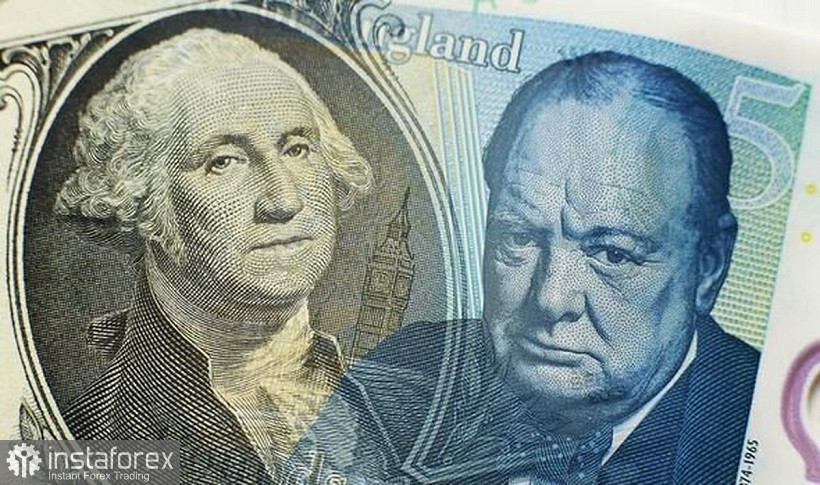The pound-dollar pair cannot determine the vector of its movement against the background of a contradictory fundamental picture. On one side of the scale is the Bank of England, whose representatives just voiced hawkish signals within the walls of the British Parliament. On the other side of the scale is Ukraine, the situation around which continues to heat up, supporting the safe dollar. This kind of "pull-push" forces traders to trade in a wide-range flat, on the border of 35 and 36 figures. Conflicting signals of a fundamental nature deter both bulls and bears of GBP/USD.
Let's start with the British events. Parliamentary hearings on the Bank of England's monetary policy report were held in the House of Commons today. Members of the monetary committee of the British central bank quarterly, after the release of the report, appear before the Treasury Committee, where they answer questions from deputies, explaining their vision of the situation in the economy. They also report on how they voted at the last BoE meetings, explaining their position if necessary. As part of today's hearing, the heads of the central bank – BoE Governor Andrew Bailey and his deputy Ben Broadbent, as well as some "ordinary" members of the Committee, in particular Jonathan Haskel and Silvana Tenreyro, spoke.

In general, the rhetoric of the representatives of the British central bank was hawkish. In particular, Ben Broadbent confirmed that the central bank will continue to tighten monetary policy by raising the interest rate. At the same time, he avoided specifics about the rate of increase and targets. Instead, the deputy head of the central bank voiced a rather interesting phrase: "I doubt that interest rates will return to the level at which the bank's Monetary Policy Committee began its work 25 years ago" (since May 6, 1997, the Bank of England has had the operational right to regulate interest rates).
In this context, it should be recalled that back in 1997, the interest rate was initially at 6%, and by the end of the year it had increased to 7.5%. If we consider Broadbent's phrase as a definition of the boundary line of the rate increase, then the British central bank has a serious "power reserve". However, according to many analysts, in this case, the representative of the central bank expressed himself figuratively, without reference to any specific figures.
Nevertheless, Broadbent's phrase fits into the canvas of hawkish rhetoric - both on his part and on the part of his colleagues. For example, Bailey followed the example of Federal Reserve Chairman Jerome Powell, abandoning the epithet "temporary" in relation to inflation. According to him, the members of the central bank began to use this concept too often in relation to inflationary trends. I note that the head of the Fed voiced a similar position at the end of last year. Since then, the Fed has gradually tightened its rhetoric regarding the prospects for monetary policy.
Another representative of the BoE, Jonathan Haskell, warned that inflation will show strong growth this year, including due to a possible increase in world gas prices. He also noted that the leading indicators of inflation and wages of the BoE are of concern. I note that Haskell was one of the four representatives of the Committee who proposed at the last meeting to raise the interest rate by 50 basis points at once. In his latest speech to the MPs, he again repeated the theses voiced earlier about the risks of high inflation.
In other words, the BoE just made it clear that it is ready to continue along the path of tightening monetary policy. This fact helped the British currency, paired with the greenback, to update the two-day high, especially against the background of British Prime Minister Boris Johnson's recent decisions regarding quarantine restrictions (the head of the British government canceled the last COVID restrictions yesterday).
But geopolitics did not allow GBP/USD bulls to gain a foothold within the 36th figure. The situation around Ukraine continues to escalate. Russia has officially recognized the DPR and the LPR within the borders of the Donetsk and Luhansk regions, although the self-proclaimed republics actually control only a smaller part of them. At the same time, the leaders of the L/DPR explicitly stated the need (in the future) to expand the actual borders to the lines "established in the constitutions." According to a number of experts, the request of Donetsk and Lugansk for military assistance from the Russian Federation to restore control over their territory may lead to a direct military clash between Moscow and Kiev. At the same time, analysts remind that, according to presidential decrees, the Ministry of Defense of Russia must ensure the "maintenance of peace" on the territory of the republics by the forces of the Russian army.
Of course, these are just hypothetical assumptions of some military and political experts. There are also peaceful, diplomatic options for the development of events. However, the market focuses its attention primarily on alarm signals. For example, today Ukraine has imposed a state of emergency on the territory of the whole country. Yesterday, Ukrainian President Volodymyr Zelenskyy signed a decree on conscription of reservists. The growth of anti-risk sentiment is also facilitated by reports from US representatives that Russia has pulled from 170 to 190,000 military personnel to the Ukrainian borders.
Given this information flow and the absence of signs of de-escalation, it can be assumed that the longs for the GBP/USD pair are extremely risky - even despite the pronounced hawkish position of the BoE. Geopolitics is still in the focus of traders' attention, while all other fundamental factors (macroeconomic reports and comments from central bank representatives) have faded into the background. Therefore, for the GBP/USD pair, it is advisable to take either a wait-and-see position, or consider selling on the upward spikes. The support level (the target of the downward movement) is the 1.3510 mark – this is the Kijun-sen line on the D1 timeframe.





















